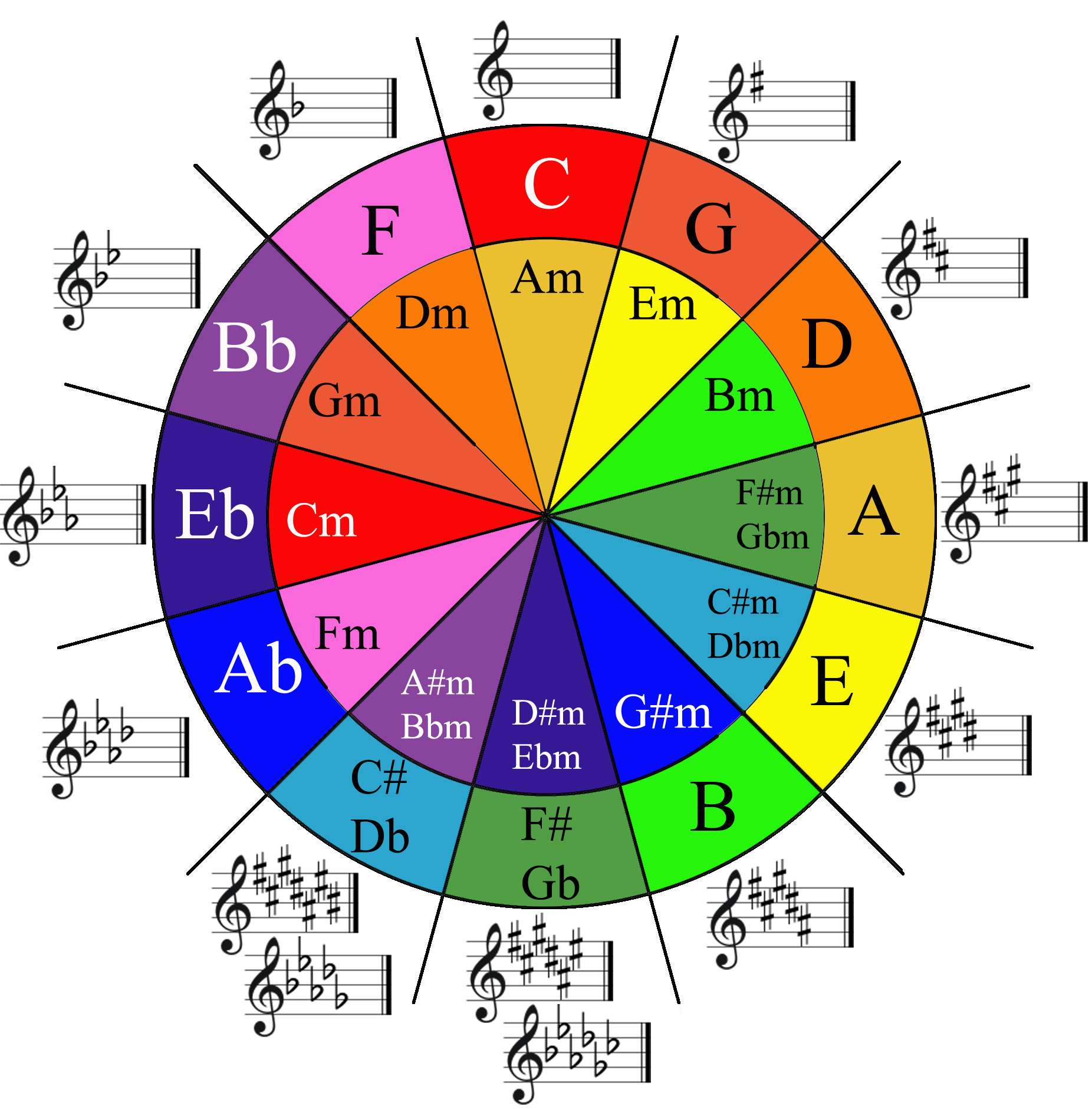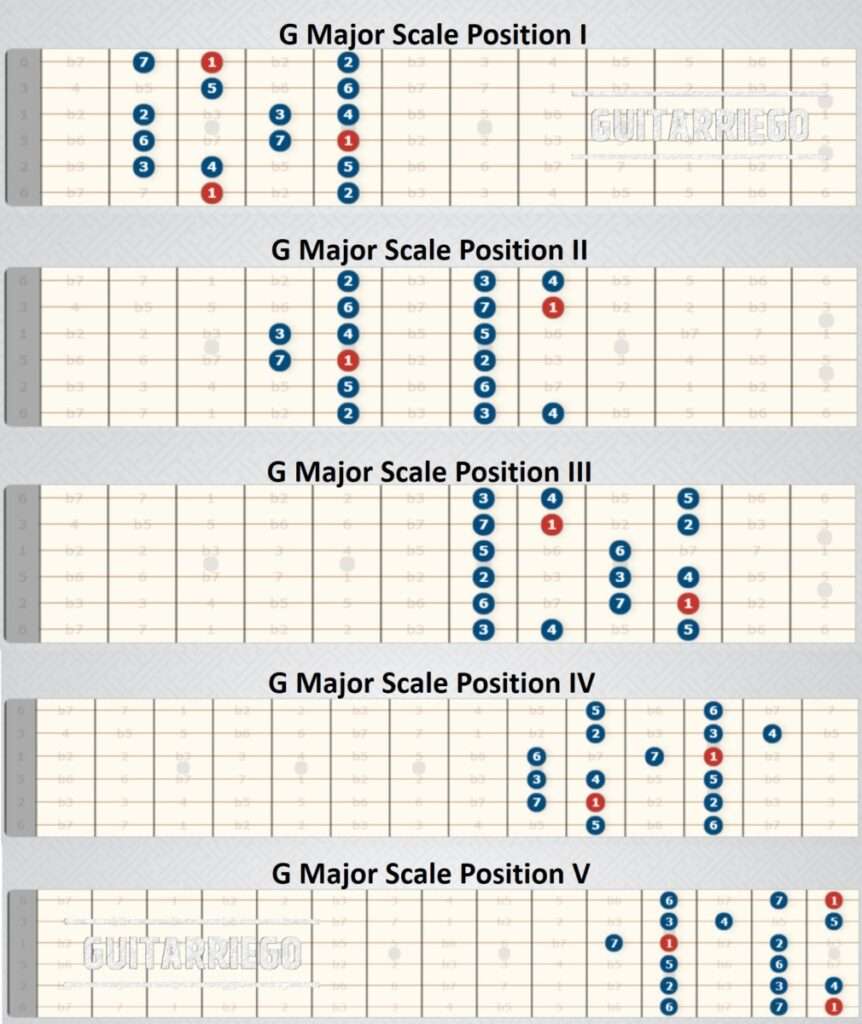Major scales are a fundamental aspect of music theory and are commonly used in a variety of musical genres. On the guitar, major scales are played using a specific sequence of notes and finger positions on the fretboard.
Learning major scales is important for guitarists because it helps with developing finger dexterity, improving musical ear training, and providing a foundation for improvisation and soloing.

Understanding Major Scales
If you didn’t already know, music is not so much about the individual notes but the space in between them. This leads us to topic of intervals. The most basic intervals in western music are half steps and whole steps.
Major scales are a set of seven notes arranged in a specific pattern of whole and half steps that create a specific tonality or mood. They are constructed using the formula W-W-H-W-W-W-H, where W represents a whole step (two frets on the guitar) and H represents a half step (one fret on the guitar).
For example, starting on the note C, the C major scale would be C-D-E-F-G-A-B, following the pattern of W-W-H-W-W-W-H.
Other examples of major scales include G major (G-A-B-C-D-E-F#)
D major (D-E-F#-G-A-B-C#)
A major (A-B-C#-D-E-F#-G#)
Each major scale corresponds to a specific key, which is named after the tonic note (the first note of the scale). Remember that on the guitar, a whole step is 2 frets and a half step is one fret.
Related: Guitar Scale Basics
The Circle of Fifths
Every key comes along with a key signature, which tells which tones need to be raised or flatted in order to make the scale. The circle of fifths is a useful tool for musicians to understand the relationships between keys. It is a circular diagram that displays the order of the major and minor keys, arranged in ascending fifths (or descending fourths).
As you move clockwise around the circle, each successive key has one additional sharp, and as you move counterclockwise, each key has one additional flat.This is how you learn your scales.

Positioning On The Guitar
Knowing the positions of major scales on the guitar is crucial because it allows guitarists to play in any key, as the positions can be shifted up or down the fretboard to play in different tonalities. This is particularly useful for improvisation and soloing.
Break it down: Start by learning the scale positions one at a time, focusing on each note and its corresponding fret and string. Play the scale slowly and deliberately, making sure to hit each note cleanly and accurately.
- Practice in different keys: Once you’ve mastered one scale position, try playing it in different keys. This will help you to recognize the underlying pattern of whole and half steps that make up the scale, and make it easier to learn other positions.
- Use visual aids: Diagrams and charts can be very helpful in visualizing the scale positions on the fretboard. You can find these online or create your own, and use them as a reference when practicing.
- Create a practice routine: Incorporate scale practice into your regular practice routine, and try to practice scales in different positions and keys every day. This will help you to build muscle memory and develop a strong foundation of knowledge.
- Play with others: Practicing scales with other musicians is a great way to reinforce your knowledge and build confidence. Playing along with a backing track or jamming with other guitarists can also be a fun and rewarding way to practice.
Remember, the key to memorizing the positions of major scales on the guitar is consistent practice and repetition. With time and dedication, you’ll be able to master the positions of major scales and take your guitar playing to the next level.

Using Major Scales In Music
Major scales are used to create a bright, happy, or uplifting tonality and are commonly used as the basis for chord progressions, melodies, and harmonies. Major scales are also used in improvisation, soloing, and composition, as they provide a framework for creating melodies and harmonies that sound pleasing to the ear.
Here are some popular songs that use major scales:
- “Happy Birthday” – This classic birthday song is a great example of a major scale in action. The melody is based on the C major scale, with the notes C-D-E-F-G-A-B. Learn to play Happy Birthday with guitar chords here
- “Twist and Shout” by The Beatles – This upbeat rock and roll classic is based on the D major scale, with the notes D-E-F#-G-A-B-C#.
- “Don’t Stop Believin'” by Journey – This iconic rock anthem is based on the E major scale, with the notes E-F#-G#-A-B-C#-D#.
- “Somewhere Over the Rainbow” by Harold Arlen – This beautiful ballad from The Wizard of Oz is based on the C major scale, with the notes C-D-E-F-G-A-B.
- “What a Wonderful World” by Louis Armstrong – This timeless classic is based on the F major scale, with the notes F-G-A-Bb-C-D-E.
Frequently Asked Questions
How many scales should a guitarist know?
Many guitarists do not actually know many scales. I would say they need to know as many as they need in their playing.
What is the difference between chords & major scales?
Chords are notes played at the same time, or harmonically. Scales are individual notes played melodically, or one after the other. A chord typically is only 3 or 4 notes. Whereas a scale is typically 7 notes long.
What guitar scales should I learn first?
Rudimentary scales a beginning guitarist should learn are the major scales, minor scales, the pentatonic scale, the blues scale, and 3 note per string scales (or the modes).
How do you memorize major & minor scales?
It is easy for guitarists to become lazy because the shape is the same for every major scale. In order to learn your major scales, you should test yourself by learning the key signatures of every key, so that way you aren’t missing out on fundamental knowledge that other instrumentalists get.
Should I learn all guitar scales?
You don’t have to. Most keys are rarely used apart from classical music. For a guitarist the major and minor sharp keys are important. Maybe F major and D minor as well. E major and E minor are probably the most common keys used among guitarists, but you should be well versed in other keys as well for those times that you play with other instrumentalists.
What is the blues scale on guitar?
The blues scale is a musical scale that is commonly used in blues music and other genres that are influenced by it. It is a six-note scale that includes the root, flat third, fourth, flat fifth, fifth, and flat seventh notes of the major scale.
Are all major scales the same?
Yes and no. In terms of shapes on the guitars neck, yes. In terms of intervals, yes. However every major key has a different key signature that needs to be taken into account.
How do you know if a key is major or minor?
Play it and listen to how it sounds. The minor scale has a flat third. The major scale has a major 3rd.
When looking at music, you can look for the leading tone accidental. The 7th scale degree is almost always raised in minor keys.
Conclusion
The Major scale is fundamental to all music. Major keys are the most common keys used in modern music. The formula for building a major scale is WWHWWWH.
You can use this pattern to build a major scale on any note on the guitar. The Circle of Fifths is a tool that helps us visualize all the keys and key signatures. Practice playing your major scales in every key!
